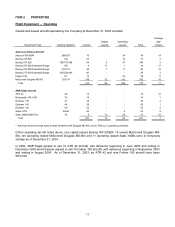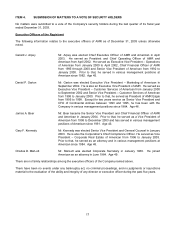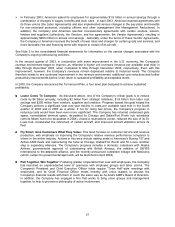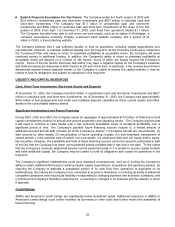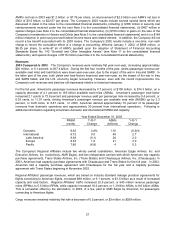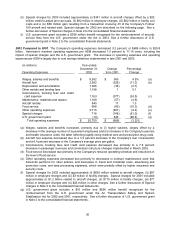American Airlines 2003 Annual Report Download - page 22
Download and view the complete annual report
Please find page 22 of the 2003 American Airlines annual report below. You can navigate through the pages in the report by either clicking on the pages listed below, or by using the keyword search tool below to find specific information within the annual report.
20
ITEM 7. MANAGEMENT'S DISCUSSION AND ANALYSIS OF
FINANCIAL CONDITION AND RESULTS OF OPERATIONS
Forward-Looking Information
The discussions under Business, Properties and Legal Proceedings and the following discussions under
Management's Discussion and Analysis of Financial Condition and Results of Operations contain various forward-
looking statements within the meaning of Section 27A of the Securities Act of 1933, as amended, and Section 21E
of the Securities Exchange Act of 1934, as amended, which represent the Company's expectations or beliefs
concerning future events. When used in this document and in documents incorporated herein by reference, the
words "expects," "plans," "anticipates," “believes,” and similar expressions are intended to identify forward-looking
statements. Forward-looking statements include, without limitation, the Company’s expectations concerning
operations and financial conditions, including changes in capacity, revenues, and costs, future financing needs,
overall economic conditions, plans and objectives for future operations, and the impact on the Company of its
results of operations for the past three years and the sufficiency of its financial resources to absorb that impact.
Other forward-looking statements include statements which do not relate solely to historical facts, such as, without
limitation, statements which discuss the possible future effects of current known trends or uncertainties, or which
indicate that the future effects of known trends or uncertainties cannot be predicted, guaranteed or assured. All
forward-looking statements in this report are based upon information available to the Company on the date of this
report. The Company undertakes no obligation to publicly update or revise any forward-looking statement, whether
as a result of new information, future events, or otherwise. The risk factors listed at the end of this Item, in addition
to other possible risk factors not listed, could cause the Company's actual results to differ materially from those
expressed in forward-looking statements.
Overview
The events of the past several years have had a material adverse impact on the Company's finances. The
Company incurred operating losses of $0.8 billion, $3.3 billion and $2.5 billion for the years ended December 31,
2003, 2002 and 2001, respectively. The Company incurred net losses of $1.2 billion, $3.5 billion and $1.8 billion
for the years ended December 31, 2003, 2002 and 2001, respectively.
These losses reflect, among other things, a substantial decrease in the Company's revenues, which began in early
2001. The revenue decrease has been driven by a number of factors, some of which the Company believes will
persist indefinitely or permanently. These factors include: (i) a steep fall-off in the demand for air travel,
particularly business travel, primarily caused by weakness in the U.S. economy, (ii) reduced pricing power,
resulting mainly from greater cost sensitivity on the part of travelers, especially business travelers, increasing
competition from low-cost carriers (LCCs) and the continuing increase in pricing transparency resulting from the
use of the Internet and (iii) the aftermath of the terrorist attacks of September 11, 2001, which accelerated and
exacerbated the trend of decreased demand and reduced industry revenues.
In response to decreased demand following the events of September 11, 2001, the Company reduced its
operating schedule by approximately 20 percent and reduced its workforce by approximately 20,000 jobs.
Subsequent to these reductions, the Company determined that achieving $4 billion in annual capacity-independent
cost savings was necessary to offset the revenue decline and initiated the following restructuring activities to
realize this goal:
• In 2002, the Company announced a series of initiatives to reduce its annual costs by $2 billion. These
initiatives are being implemented through 2005, and involve: (i) scheduling efficiencies, including the de-
peaking of certain of its hubs, (ii) fleet simplification, (iii) streamlined customer interaction, (iv) distribution
modifications, (v) in-flight product changes, (vi) operational changes and (vii) headquarters/administration
efficiencies. As a result of the initiatives, the Company reduced an estimated 7,000 jobs by March 2003.



